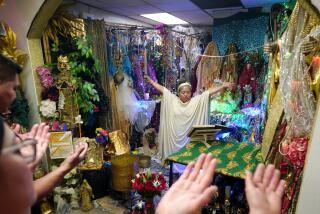STATE OF MIND : Giving Peace a Chant
- Share via
V eni, Sancte, Spiritus. “
It’s a diverse group singing this chant: Catholics, Presbyterians, Episcopalians, Eastern Orthodox, as well as a Hindu, a Buddhist from Canada and an Orthodox Jew who survived the Holocaust. All have come to a daylong conference in Montecito to learn about Taize, an ecumenical movement with its roots in Nazi-occupied France.
Taize has drawn hundreds of Southern Californians into its fold and at least six regional churches, including All Saints Episcopal in Beverly Hills, occasionally offer Taize services.
Founded in the French village of Taize during WWII by a Swiss emigre, Taize is a unique community. This irenic form of Christian worship welcomes members of any and all faiths, but is affiliated with no organized denomination. Its founder and leader, known as Brother Roger, refuses to let it grow into a formal movement and rejects donations. Its aim is simple: world peace and an end to religious differences through prayer, silent meditation and chants.
At the conference at La Casa de Maria, a Montecito retreat, all 200 attendees recite a Taize chant: “When the night becomes dark, your love, oh Lord, is a fire.” They continue for many minutes; then, almost mystically, the chanting ends at precisely the same moment.
“What you’re sensing today is what Taize hopes for in its worship: a movement toward prayer breaking down barriers, toward the all-embracing love of God,” says Ann Jaqua, the conference leader. “We are told by the mystics that dark and light are the same things in this place of deep worship, the place where reconciliation and healing takes place.”
In Southern California, people of every age attend Taize services, but in Europe, it is a phenomenon of youth: Every year, more than 100,000 pilgrims--most under 30--visit the tiny town of Taize, tucked in the hills of Burgundy. Three times a day, they sit with the 90 or so Taize brothers, both Protestant and Catholic, in the Church of the Reconciliation to pray and chant. Most chants, often done in dim light or total darkness, are in Latin, but Polish, Greek and even Japanese are not unusual.
The Rev. Kittredge Cherry of the Metropolitan Community Church of Los Angeles, which sponsored a recent Taize festival in West Hollywood, spent Holy Week in the Burgundy town. “It was an awesome sight,” she says. “All night long, youngsters from all over the world came and prostrated themselves at the church’s cross. They’d just lie there and sob.
“These were tough kids, the kind you’d imagine with nails in their nose and tattoos on every limb,” Kittredge says. “And when they’d get up, it looked as if terror had eroded from the world.”
More to Read
Sign up for Essential California
The most important California stories and recommendations in your inbox every morning.
You may occasionally receive promotional content from the Los Angeles Times.













